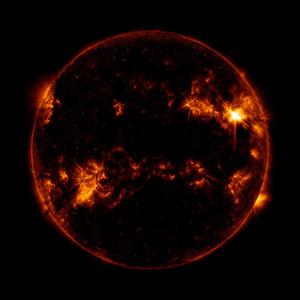Glossary term: Solar Flare
Description: A solar flare is a brief brightening on one part of the Sun.
The Sun is surrounded by a complex magnetic field. Sometimes this magnetic field becomes unstable, shifting its structure and releasing huge amounts of stored energy. This causes a localized heating of the Sun's atmosphere and leads to a small fraction of the Sun's photosphere becoming brighter. This can also lead to huge streams of particles being flung out into space (known as a coronal mass ejection).
Most solar flares change the brightness of the Sun by amounts barely noticeable to the human eye and can only be seen by solar telescopes or by space telescopes monitoring the Sun.
The coronal mass ejections from the Sun can cause geomagnetic storms if they come close enough to the Earth to interact with the Earth's magnetic field.
Other stars also have flares (known as stellar flares) but, as we see the stars as points of light, we only see these flares as brief brightenings of the star.
Related Terms:
See this term in other languages
Term and definition status: This term and its definition have been approved by a research astronomer and a teacher
The OAE Multilingual Glossary is a project of the IAU Office of Astronomy for Education (OAE) in collaboration with the IAU Office of Astronomy Outreach (OAO). The terms and definitions were chosen, written and reviewed by a collective effort from the OAE, the OAE Centers and Nodes, the OAE National Astronomy Education Coordinators (NAECs) and other volunteers. You can find a full list of credits here. All glossary terms and their definitions are released under a Creative Commons CC BY-4.0 license and should be credited to "IAU OAE".
Related Media
Solar flare
Credit: NASA/SDO credit link
License: PD Public Domain icons









